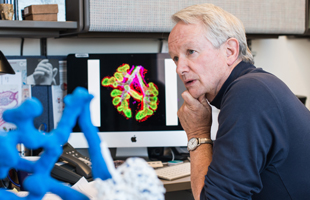Neonatology Research Highlights

Research programs in the Division of Neonatology encompass a broad array of both clinical and basic science research areas, but each program is aligned with our singular vision to advance care for all newborns. Below are 2019 highlights from a few key areas of study.
Statin as a novel pharmacotherapy of pulmonary alveolar proteinosis
Pulmonary alveolar proteinosis (PAP) is a disease manifest by decreased surfactant clearance leading to respiratory failure for which the pathogenetic mechanism is unknown. In this study, Cormac McCarthy, MD, PhD, and colleagues examine the lipids accumulating in alveolar macrophages and surfactant to define the pathogenesis of PAP and evaluate a novel pharmacotherapeutic approach. In PAP patients, alveolar macrophages demonstrated a significant increase in cholesterol. Oral statin therapy resulted in clinical, physiological, and radiological improvement in autoimmune PAP patients.
Single cell RNA analysis identifies cellular heterogeneity and adaptive responses of the lung at birth
In this study, single cell analyses were performed to identify the heterogeneity of pulmonary cell types and dynamic changes in gene expression mediating adaptation to respiration. Distinct populations of epithelial, endothelial, mesenchymal, and immune cells, each containing distinct subpopulations during adaptation to air breathing after birth, were revealed at a level of resolution far exceeding previous understanding. Minzhe Guo, PhD, and colleagues found the data demonstrates that the adaptation to breathing on the first day of life causes endoplasmic reticulum (ER) stress responses in lung epithelial cells that produce surfactant and regulate immunity. The adaptive response of alveolar type 2 cells serves to protect lung progenitor cells during the stress of breathing at birth and after injury or infection.
The long noncoding RNA Falcor regulates Foxa2 expression to maintain lung epithelial homeostasis and promote regeneration
In this study, Daniel T. Swarr, MD, and colleagues identified a novel regulatory feedback loop between the transcription factor Foxa2 and a downstream long noncoding (lnc)RNA, Falcor (Foxa2-adjacent long noncoding RNA). Foxa2 directly repressed Falcor expression by binding to its promoter, while Falcor functioned in cis to positively regulate the expression of Foxa2. In the lung, loss of Falcor is sufficient to lead to chronic inflammatory changes and defective repair after airway epithelial injury. Thus, lncRNA Falcor functions within a regulatory feedback loop to fine-tune the expression of Foxa2, maintaining airway epithelial homeostasis.
Dosing and formulation of antenatal corticosteroids for fetal lung maturation and gene expression in rhesus macaques
Antenatal corticosteroids (ANS) treatment is the standard of care for lung disease due to prematurity. The most widely used treatment is two intramuscular doses of a 1:1 mixture of betamethasone-phosphate (Beta-P) and betamethasone-acetate (Beta-Ac); however, dosing has never been optimized to provide the dose both maximizing therapeutic benefit and minimizing potential harmful effects. The research team, including Jeffrey Whitsett, MD, and Alan Jobe, MD, PhD, used a primate model to test the efficacy of the slow release Beta-Ac alone for enhancing fetal lung maturation and to reduce fetal corticosteroid exposure and potential toxic effects. Beta-Ac alone increased lung compliance and surfactant concentration in the fetal lung equivalently to the current clinical regimen with a much lower overall ANS exposure. This result suggests that a low dose ANS treatment with Beta-Ac should be assessed for efficacy in human trials.

